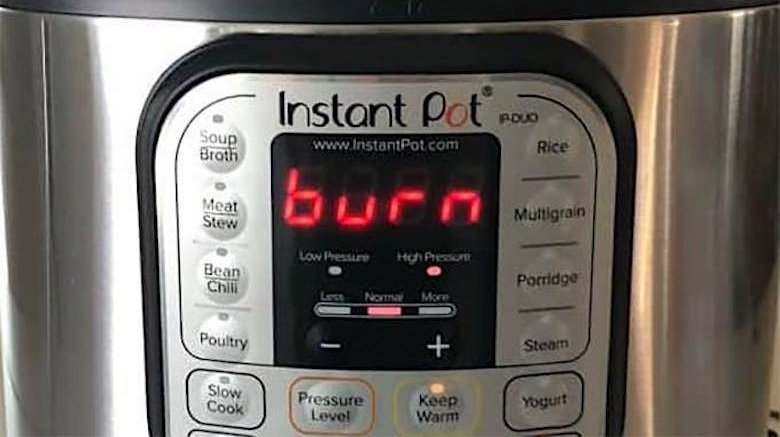What To Do When Your Instant Pot Says 'Burn'
The Instant Pot makes dinner a total breeze, and if you're a parent it's a lifesaver on busy weeknights when you forgot to plan ahead for dinner. But we can't help but panic when we're making dinner and our Instant Pot suddenly reads "burn." Is dinner ruined? Is the Instant Pot ruined? If you're ever faced with the same conundrum, here's exactly what to do when your Instant Pot says "burn" or "ovht."
First of all, there's no need to panic — the "burn" or "ovht" message can show up on your Instant Pot's digital display before dinner is ruined (via Pressure Cook Recipes). In fact, the function of the "burn" message is to let you know that your food is overcooking and getting dry, and that the pot has switched off. This helps prevent your food from burning further (and also prevents damage to your precious Instant Pot), meaning dinner might still be salvageable (via The Kitchn). The burn message might also turn on if the sauce you're cooking your food in is too thick.
If you get a "burn" message, you should hit the "cancel" button on your Instant Pot. This will allow it to vent its pressure to make it safe for you to open the lid to see what's going on with your food.
For overcooked food, use a spoon to scrape away any burnt-on bits. Once the bottom of the pot is clear and you've waited for it to cool off, you can start cooking again.
If there isn't any burned food at the bottom of the pot, try adding more liquid, whether that be water, stock, or wine, and stir it in to the rest of the dish, making sure it gets down to the bottom of the pot. Let the pot cool down, then proceed with cooking as usual.
To prevent the "burn" message on your Instant Pot from appearing in the future, there are a few things you can do. Make sure that everything you cook uses adequate liquid (you might have to modify recipes not written specifically for Instant Pot cooking), don't add thickeners to your sauces and soups, add dairy ingredients to your dish after it's done cooking, and try to layer your ingredients so the thicker items in a sauce, like tomato paste or hoisin sauce, go in last (via The Kitchn).
